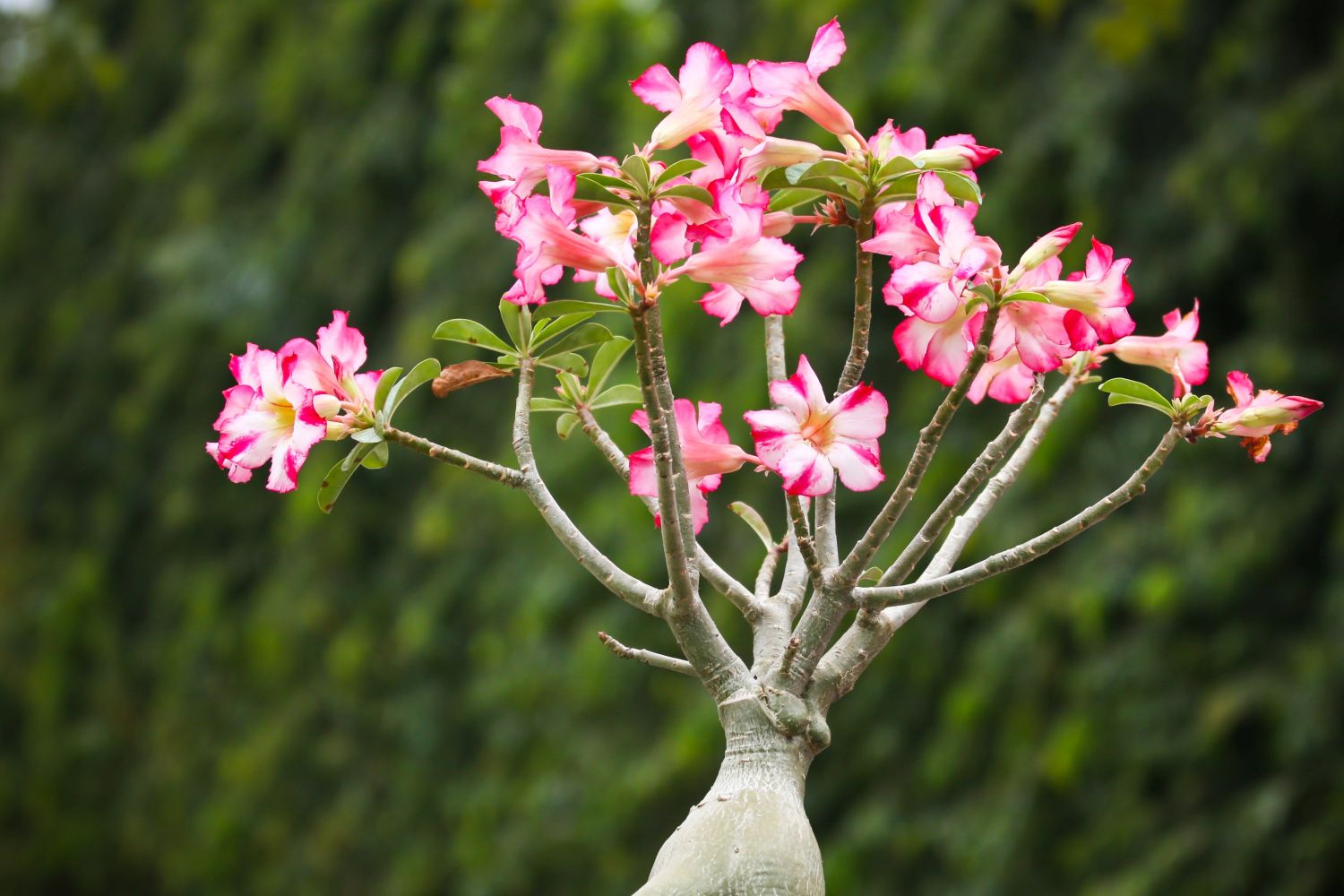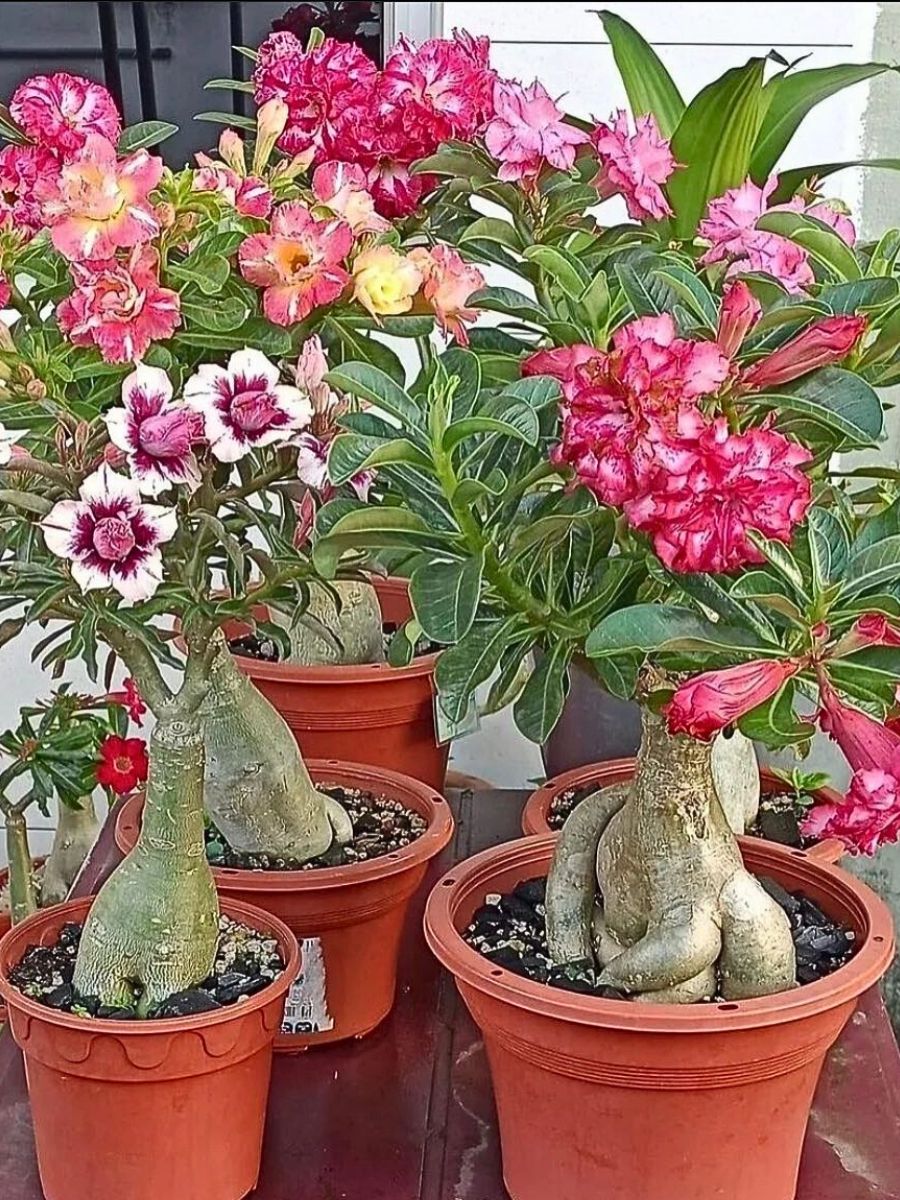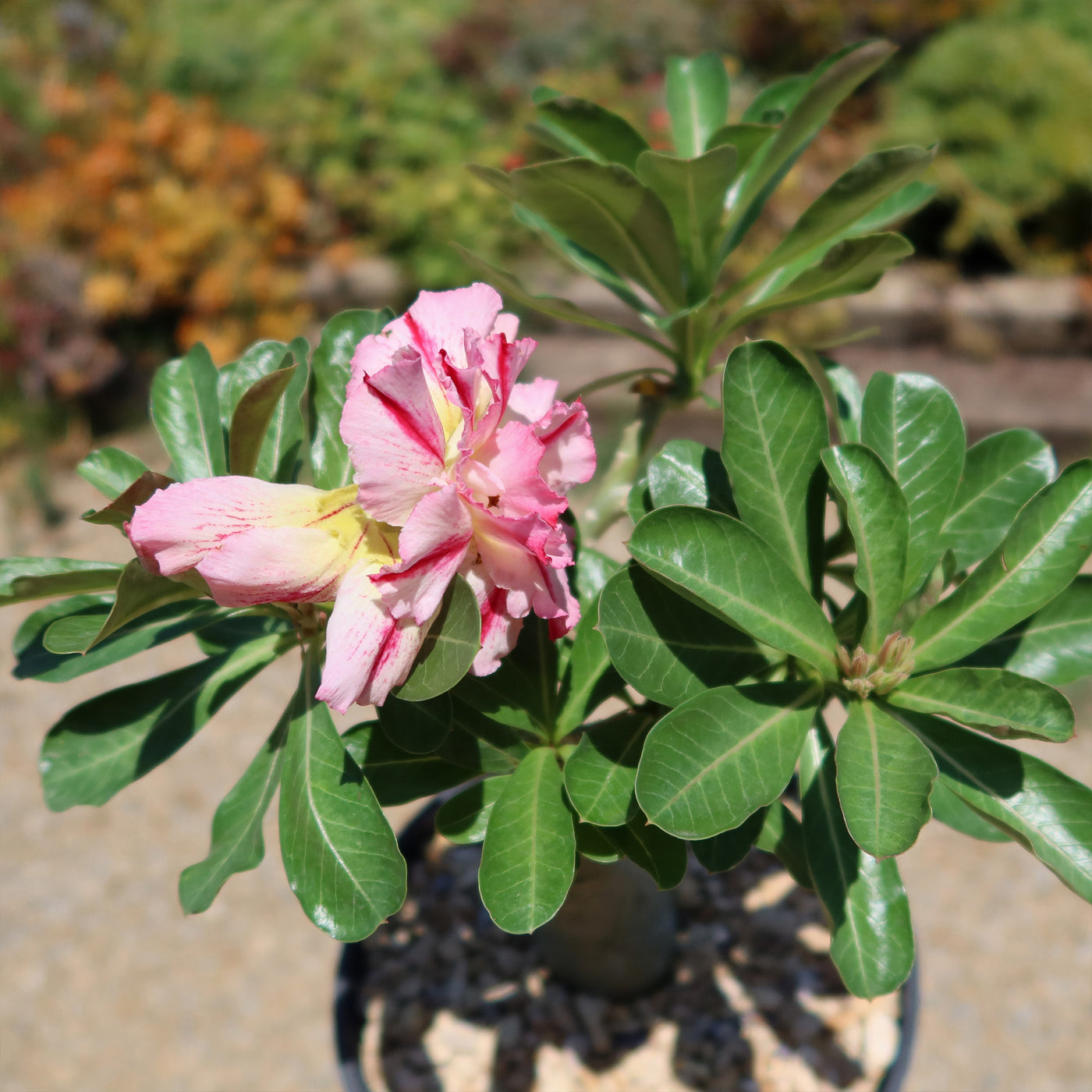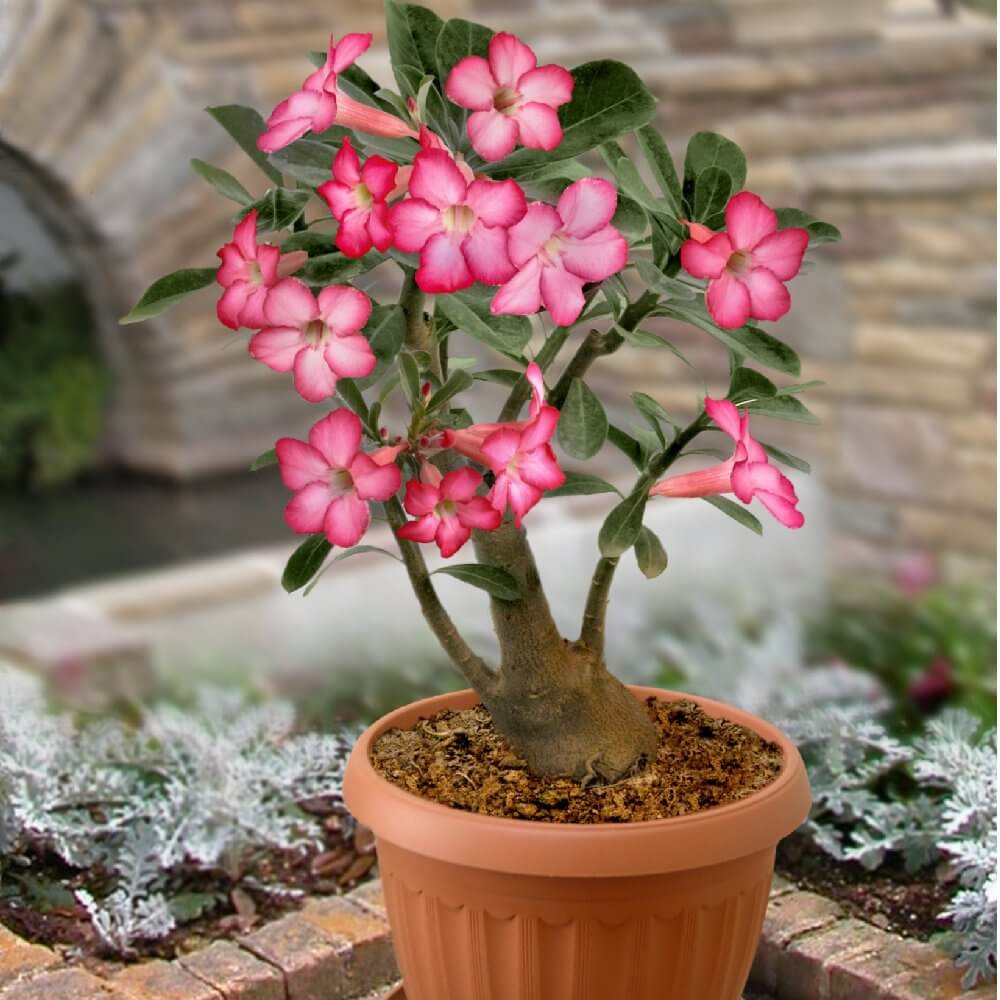Unveiling the Desert Rose: Your Guide to the Magnificent Adenium plant
Hey there, plant lovers! Ever seen a plant that looks like it’s straight out of a fairytale, boasting vibrant, trumpet-shaped flowers and a stout, sculptural trunk? Chances are, you’ve encountered the mesmerizing Adenium, more popularly known as the Desert Rose. These beauties are not just your average houseplant; they’re resilient, stunning, and, with a little know-how, incredibly rewarding to grow. So, let’s dive deep into the world of Adeniums and uncover everything you need to know about these fascinating desert dwellers.
What Exactly is an Adenium?
At its core, an Adenium is a genus of flowering plants in the dogbane family, Apocynaceae. Native to arid regions of Africa and the Arabian Peninsula, they’ve adapted perfectly to harsh desert conditions, developing unique characteristics that make them stand out. The most striking feature? Their swollen base, known as a caudex. This isn’t just for show; it’s a clever evolutionary adaptation for water storage, allowing them to survive long periods of drought. Think of it as their built-in camel hump!

While there are several species of Adenium, the most commonly cultivated one is Adenium obesum. This is the one you’ll typically find gracing garden centers and plant nurseries with its spectacular blooms. But don’t let the “desert” in their name fool you into thinking they’re bland. Adeniums come in an astonishing array of colors, from classic pinks and whites to fiery reds, deep purples, and even multi-colored hybrids. Each flower is a miniature masterpiece, often with contrasting throats and delicate veins.
Why Grow an Adenium? The Allure of the Desert Rose
So, beyond their undeniable good looks, why should you consider adding an Adenium to your plant collection? There are several compelling reasons:
Stunning Visual Appeal

Let’s be honest, the primary draw for many is their sheer beauty. The combination of the unique caudex, the elegant stems, and the explosion of vibrant flowers makes them true showstoppers. They add a touch of exotic charm to any space, whether it’s a sunny windowsill, a patio, or even a rock garden in warmer climates.
Drought Tolerance and Low Maintenance (Relatively!)
Because of their desert origins, Adeniums are incredibly drought-tolerant once established. This makes them a fantastic choice for those who might occasionally forget to water, or for busy individuals who want a beautiful plant without constant fuss. While they do appreciate regular watering during their growing season, they’re much more forgiving than many other flowering plants.
Longevity and Character

With proper care, an Adenium can live for many years, even decades. As they age, their caudex continues to grow and develop, creating a unique, gnarled, and artistic form. It’s like having a living sculpture that evolves over time, telling a story with its twists and turns.
Rewarding Blooms
The satisfaction of seeing your Adenium burst into bloom is truly unparalleled. After a period of dormancy, when the weather warms and the days lengthen, those beautiful buds begin to swell, promising a spectacular display. And they often bloom multiple times throughout the growing season, providing continuous delight.
How to Make Your Adenium Thrive: A Deep Dive into Care

While Adeniums are relatively easygoing, there are a few key things to keep in mind to ensure they truly flourish. Think of it as providing them with a little taste of their desert home, but with all the comforts they need to perform at their peak.
Sunlight is King
This is perhaps the most crucial factor for a happy Adenium. They are sun worshippers through and through. Aim for at least 6-8 hours of direct sunlight per day. A south-facing window is ideal if you’re growing indoors. If you’re in a climate where you can keep them outdoors, find a spot that gets full, unadulterated sun. Lack of adequate light will lead to leggy growth, fewer flowers, and a generally unhappy plant.
Watering Wisdom: Less is More (But Not Always!)

This is where many new Adenium growers make mistakes. Remember that caudex? It’s there for a reason. Overwatering is the quickest way to send your Adenium to an early grave. During their active growing season (spring and summer), water thoroughly when the top inch or two of soil feels dry to the touch. Let the water drain completely. Never let your Adenium sit in standing water.
During their dormant period (typically in cooler months), significantly reduce watering. Some growers even stop watering almost entirely, especially if temperatures drop. The key is to observe your plant. If the caudex starts to feel a bit soft and wrinkled, it’s time for a light drink. But err on the side of underwatering rather than overwatering.
The Right Pot and Soil: Drainage is Non-Negotiable
Good drainage is paramount for Adeniums. They absolutely despise soggy feet. Choose a pot with ample drainage holes. Terracotta pots are often a good choice as they are porous and allow for better airflow to the roots.
For the soil, think gritty and fast-draining. A typical succulent or cactus mix is a great starting point. You can further enhance it by adding perlite, pumice, coarse sand, or even small lava rocks to improve drainage and aeration. Avoid heavy, water-retentive potting soils at all costs.
Temperature Talk: Warmth is Welcome
Adeniums are tropical plants and thrive in warm temperatures. They prefer temperatures between 65°F (18°C) and 95°F (35°C). They are not frost-tolerant and will suffer significant damage or even die if exposed to freezing temperatures. If you live in a climate with cold winters, you’ll need to bring your Adenium indoors before the first frost.
Feeding Your Desert Rose: A Little Nurturing Goes a Long Way
While they’re not heavy feeders, Adeniums do benefit from occasional fertilization during their active growing season. Use a balanced liquid fertilizer, diluted to half strength, once every 2-4 weeks. Look for a fertilizer with a slightly higher phosphorus content to encourage blooming. Avoid fertilizing during their dormant period.
Pruning for Power and Shape
Pruning might seem intimidating, but it’s essential for maintaining the shape, health, and flowering potential of your Adenium.
Encourage Bushier Growth
If your Adenium is getting leggy, or you want to encourage a more branched, bushier habit, prune back the stems. Make your cuts just above a leaf node. This will stimulate new growth from that point.
Promote More Blooms
Pruning can also encourage more flowers. When a branch has finished blooming, you can prune it back to promote new flower production.
Maintain Health
Remove any dead, diseased, or damaged branches. This helps prevent the spread of problems and keeps your plant healthy.
Repotting: Giving Them Room to Grow
Adeniums don’t mind being a little root-bound, but they will eventually need repotting, typically every 2-3 years, or when they outgrow their current pot. The best time to repot is in the spring, just as they are emerging from dormancy.
When repotting, gently remove the plant from its old pot. Inspect the roots and trim any dead or mushy ones. You can also take this opportunity to slightly raise the caudex, exposing more of its interesting shape for a more dramatic presentation. Use fresh, well-draining potting mix and a pot that’s only slightly larger than the previous one.
Dealing with Pests and Problems
While generally robust, Adeniums can sometimes encounter a few common pests and issues.
Pests
The most common culprits include spider mites, mealybugs, and aphids. Inspect your plant regularly, especially the undersides of leaves and in the crevices of the caudex. If you spot any pests, you can often dislodge them with a strong spray of water. For more persistent infestations, use an insecticidal soap or neem oil, following the product instructions carefully.
Fungal Issues
Overwatering is the primary cause of fungal problems, leading to root rot or stem rot. The best prevention is proper watering practices. If you suspect rot, you may need to unpot the plant, trim away affected areas, and repot in fresh, dry soil.
Yellowing Leaves
This can be a sign of overwatering or underwatering. Assess your watering schedule and adjust accordingly. It can also be a sign of nutrient deficiency, in which case a light feeding might be beneficial.
No Blooms
Lack of adequate sunlight is the most common reason for an Adenium not blooming. Ensure it’s getting enough direct sun. Other factors could include insufficient nutrients or too little time to establish after repotting.
Propagating Your Desert Rose: Expanding Your Collection
Want more Adeniums? You have a couple of options for propagation.
Seeds
Growing Adeniums from seed is a rewarding experience. Seeds germinate relatively easily in warm, moist conditions. The exciting part is that plants grown from seed will develop a beautiful, natural caudex. However, the resulting plants may not be true to the parent plant’s characteristics, especially if it’s a hybrid.
Cuttings
Propagating from cuttings is a quicker way to get a new plant, and it ensures the new plant will be genetically identical to the parent. However, plants grown from cuttings typically won’t develop the classic swollen caudex of a seed-grown plant. To propagate from cuttings, take a 4-6 inch cutting from a healthy branch, allow it to callus over for a few days, and then plant it in well-draining soil. Provide warmth and indirect light, and keep the soil lightly moist until roots form.
Different Species and Cultivars: A World of Variety
While Adenium obesum is the star, there are other fascinating species and countless cultivars to explore.
Adenium arabicums
Known for their exceptionally large and often more squat, rounded caudex, making them highly prized by collectors. Their flowers tend to be smaller than A. obesum.
Adenium somalense
Characterized by a more elongated, columnar caudex and often smaller leaves.
Adenium swazicum
Often features smaller flowers but in a wide range of colors, and is known for its cold tolerance compared to other species.
Beyond these species, breeders have developed an incredible array of hybrid cultivars with stunning flower forms, colors, and patterns, including double and triple petaled varieties. The world of Adeniums is constantly expanding, offering endless possibilities for collectors and enthusiasts.
Artistic Touches: Shaping Your Adenium
One of the most appealing aspects of Adeniums is their sculptural quality. Many growers enjoy shaping their plants to enhance their unique forms.
Caudex Exposure
As mentioned, gently raising the caudex during repotting can create a more dramatic, exposed root system. This highlights the plant’s natural beauty.
Branch Training
You can gently train branches using soft ties or wires to create specific shapes and encourage a more balanced silhouette. Always be gentle to avoid damaging the brittle stems.
Combining with Other Plants
Adeniums can make a striking focal point in a succulent or xeriscape garden. Their bold forms and vibrant colors contrast beautifully with other drought-tolerant plants.
Conclusion
The Adenium, or Desert Rose, is more than just a pretty face. It’s a testament to nature’s resilience and beauty, offering a unique blend of striking aesthetics, surprising hardiness, and rewarding blooms. With a little sunshine, a watchful eye on watering, and a dash of love, you can cultivate a magnificent specimen that will bring a touch of the exotic desert to your home for years to come. So, if you’re looking for a plant that truly stands out from the crowd and offers endless fascination, embark on your Adenium journey. You won’t regret it!
5 Unique FAQs About Adenium Plants
Can Adenium plants be grown outdoors year-round in colder climates?
No, Adenium plants are not frost-tolerant and will die if exposed to freezing temperatures. In colder climates (USDA zones lower than 10-11, generally), they must be brought indoors during the winter months to protect them from the cold.
Is the sap of the Adenium plant poisonous?
Yes, the sap of the Adenium plant is toxic if ingested and can cause skin irritation upon contact. It’s advisable to wear gloves when handling the plant, especially when pruning, and keep it away from pets and small children.
Why is my Adenium’s caudex shrinking or feeling soft?
A shrinking or soft caudex usually indicates a watering issue. If it’s accompanied by yellowing leaves, it’s often a sign of overwatering and root rot. If the soil is completely dry and the caudex is soft, it could be extreme underwatering. Assess your watering habits and adjust accordingly.
Can I grow an Adenium from a stem cutting and expect it to develop a large caudex?
While you can successfully propagate Adeniums from stem cuttings, the resulting plants typically will not develop the prominent, swollen caudex that is characteristic of plants grown from seed. The caudex forms from the taproot, which is only present in seed-grown plants.
My Adenium has stopped blooming, even though it’s getting plenty of sun. What could be wrong?
Beyond sufficient sunlight, several factors can affect blooming. It might need a boost of phosphorus-rich fertilizer during its growing season. The plant could also be too young to bloom consistently, or it might be experiencing stress from recent repotting or significant temperature fluctuations. Ensure consistent warmth and a proper feeding schedule.
Adenium Plant
